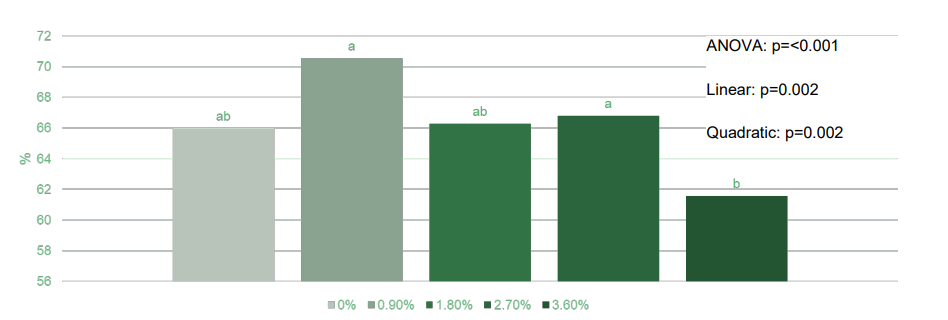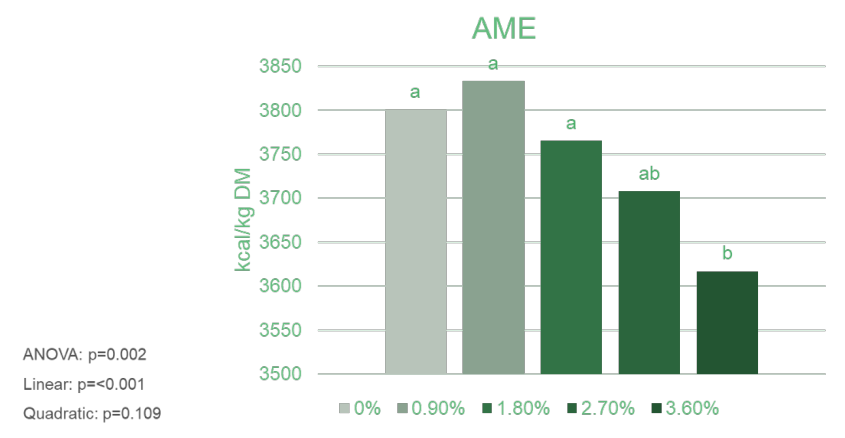



Soybean meal can impair nitrogen retention and energy metabolization
The antinutritional galacto-oligosaccharides from soybean meal in broiler starter feed also impair metabolizable energy and dietary N retention.Soybean meal (SBM) is an excellent protein source commonly used in poultry feed, being included at high levels in starter diets due to the high protein and amino acid requirements at early ages. Although the inclusion of SBM is much higher in feed for young chicks than in diets for adult birds, digestibility and apparent metabolizable energy (AME) studies are not usually carried out with young birds, which can lead to an error when applying these values obtained with physiologically mature birds to feed formulation for still immature chicks. Furthermore, table AME, protein, and digestible amino acid values for SBM vary considerably among different research institutions (WPSA 1989; NRC, 1994; Rostagno et al., 2017; CVB, 2019; INRA, 2021; FEDNA, 2021). In recent years, the use of prediction equations, likewise issued by various institutions, has become quite common. However, these equations also vary quite a bit between them since they are based on different components of SBM (Fondevila et al., 2021). All in all, it is quite complex to include SBM in (pre) starter diets formulation accurately.
Furthermore, the negative side of SBM is widely known, as it can have fluctuating contents of antinutritional factors -ANFs- (trypsin inhibitor activity -TIA-, galacto-oligosaccharides -GOS-, and betaconglycinin), as we have previously exposed on The Poultry Site (Blanch, 2020 a,b). In this sense, the effect of trypsin inhibitors on amino acid digestibility in chickens is well known and recently corroborated by Kuenz et al. (2022), who pointed that the higher the TIA in chicken feed, the lower the digestibility of amino acids. With respect to indigestible soy GOS (stachyose and raffinose), some AME prediction equations do consider the content of these oligosaccharides in SBM and their fermentability in the ceca of adult birds (Fondevila et al., 2021). However, the fermentability of soy GOS obviously depends on the profile of the intestinal microbiota, which will vary throughout the life of the chicken. The greatest change in the intestinal microbiota of chickens occurs after 14 days of life (Xi et al., 2019). Thus, it is not very accurate to consider that the use of energy from soy GOS through bacterial fermentation is the same in young chicks as in adult birds.
In addition, undigested carbohydrates such as soy GOS exert an osmotic effect in the duodenum and jejunum portion of the intestinal tract until they reach the cecal tonsils (Marteau and Boutron-Ruault, 2002). Higher osmotic pressure from the intake of harmful quantities of the antinutritional factor GOS generates abnormally aqueous digesta that increases the feed passage rate in broilers (Coussement, 1999; David and Peter, 2001), potentially reducing nutrient utilization of the diet even further. Thus, the content of soy GOS in (pre) starter diets for chicks can substantially compromise the energy and protein utilization of SBM and also that of the complete feed.
On the other hand, the content of the antinutritional factor GOS (stachyose and raffinose) in SBM varies a lot depending on the region of origin of the SBM and even within the same region, ranging approximately between 5 and 10% (García-Rebollar et al., 2016). Given this variability in the content of the antinutritional factor GOS in SBM and its potential negative effect on the nutritional value of SBM and complete feed for chicks, it is crucial to know the content of this antinutritional factor in starter diets. Depending on the content of GOS in SBM and the level of inclusion of SBM in the diet, a wide range of the antinutritional factor GOS content can be found in commercial starter diets, from 1 % (5% GOS in SBM x 20% SBM in feed; low end of range) to 3.5% (10% GOS in SBM x 35% SBM in feed; high end of range).
We have recently investigated the effect of increasing levels of soy GOS (raffinose and stachyose), as antinutritional factors, in starter feed on AME and nitrogen retention in 14-day old chicks (Brown et al., 2022). The test birds were fed with one of five dietary treatments: a control diet devoid of the soy GOS based on soy protein isolate (SPI) or the same SPI diet with 0.9, 1.8, 2.7 or 3.6% added GOS (a mix of stachyose and raffinose, 4:1 ratio, as found in SBM). The range of GOS tested encompasses the range that we could find in commercial (pre) starter diets. Both linear (p<0.01) and quadratic effects (p<0.01) were observed for nitrogen retention, the maximum value being 70.20% at 1.24% GOS, based on the quadratic regression (Figure 1). GOS contents higher than 1.24% in the starter diet would result in a lower utilization of nitrogen.

Likewise, the AME of the complete feed increased according to a quadratic regression at d14 (p<0.03), the maximum value being 4,073 kcal/kg DM at 1.61% GOS (Figure 2). In other words, AME of the starter feed will decrease when 1.61% of the antinutritive factor GOS is exceeded. It should be noted that the high level of AME in this diet was due to the use of an ANF-free SPI as the only source of protein. This AME quadratic response may indicate that up to a certain level (1.61%), the microbiota of the young chick could ferment GOS from SBM as prebiotics, but it can no longer ferment them when they exceed this level. Thus, the exceeding quantity of GOS that has not been fermented exert a damaging effect on the intestine of these immature animals.
In view of this double effect of GOS from SBM, up to a certain dietary level a prebiotic effect is observed, but also an anti-nutritional effect beyond this point. The solution is not to eliminate soy GOS completely from (pre) starter diets, but to replace part of SBM in the (pre) starter feed with a clean soy protein that has an extremely low level of GOS and other ANFs such as TIA and beta-conglycinin. Hamlet Protein A/S (Horsens, Denmark and Findlay, OH, USA) is a pioneer in the development of clean soy protein for young animal diets, having extensive experience in the positive effect of reducing soy ANFs in (pre) starter feed for chicks.

| References | ||||
|---|---|---|---|---|
| Blanch, A. | ||||
| (2020a) | Soy trypsin inhibitors do affect the growth and gut health of chickens. | |||
| Blanch, A. | ||||
| (2020b) | Soy oligosaccharides and beta-conglycinin, behind gut inflammations, wet droppings and footpad dermatitis in chickens. | |||
| Brown, K.D., et al. | ||||
| (2022) | Effect of dietary soy galacto oligosaccharides on AMEn, nitrogen retention and ceca microbiome of broiler chickens. | In Proceedings of PSA Annual Meeting, July 11-14, 2022, San Antonio, Texas (USA). | ||
| Coussement, P.A.A. . | ||||
| (1999) | Inulin and oligofructose: safe intakes and legal status... J. Nutr. | 129: 1412– 1417 | ||
| CVB | ||||
| (2019) | Chemical Composition and Nutritional Values of Feedstuffs. | Veevoedertabel. Wageningen, The Netherlands. | ||
| David, L.T. and Peter M.C. | ||||
| (2001) | Short-chain fatty acids and human colonic function: roles of resistant starch and nonstarch polysaccharides.. Physiol. Rev. | 81: 1031–1064 | ||
| Garcia-Rebollar, P. et al. | ||||
| (2016) | Influence of the origin of the beans on the chemical composition and nutritive value of commercial soybean meals.. Anim. Feed Sci. Technol. | 221: 245-261 | ||
| FEDNA | ||||
| (2021) | Tablas de Composición y Valor Nutritivo de Alimentos para la Fabricación de Piensos Compuestos, | 4ª ed., Madrid, Spain. | ||
| Fondevila, G. et al. | ||||
| (2021) | Evaluation of the energy content of soybean meals for poultry based on their chemical composition. A review of currently available prediction equations.. IN: Proceedings of the “XXXVI Curso de especialización FEDNA”, Madrid, December 1 and 2, | 2021: 59-86. | ||
| INRA | ||||
| (2021) | Tables de Composition et de Valeur Nutritive des Materies Premiéres Destinées aux Animaux d’élevage.. INRA Ed., Paris, France. | |||
| Kuenz, S. et al. | ||||
| (2022) | Effects of gradual differences in trypsin inhibitor activity on the estimation of digestible amino acids in soybean expellers for broiler chickens.. Poultry Science 101. | |||
| Marteau, P. and Boutron-Ruault, M.C. | ||||
| (2002) | Nutritional advantages of probiotics and prebiotics... Br. J. Nutr. | 87: 153–157 | ||
| NRC | ||||
| (1994) | Nutrient Requirements for Poultry. | 9th rev. ed. Natl. Acad. Press, Washington, USA. | ||
| Rostagno, H. S.et al. | ||||
| (2017) | Tabelas Brasileiras para Aves e Suínos.. In: Composiçao de Alimentos e Exigencias Nutricionais, 4th ed., Universidade Federal de Viçosa, Viçosa, Brazil. | |||
| WPSA | ||||
| (2019.) | European Table of Energy Values for Poultry Feedstuffs, 3rd ed. Subcommittee Energy of the Working Group no. 2. | Spelderholt Centre for Poultry Research, Beekbergen, The Netherlands. | ||
| Xi, Y. et al. | ||||
| (2019) | Characteristics of the intestinal flora of specific pathogen free chickens with age.. Microbial Pthogenesis | 132: 325-334 |









